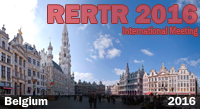RERTR Publications
ANL/RERTR/TM-27
AN ALTERNATIVE LEU DESIGN FOR THE FRM-II*
N. A. Hanan, S. C. Mo, R. S. Smith and J. E. Matos
RERTR Program
Argonne National Laboratory
Argonne, IL 60439
October 1996
*Work supported by the US Department of Energy
Office of Nonproliferation and National Security
under Contract No. W-31-109-38-ENG.
![]() PDF version available
PDF version available
DOWNLOAD full paper in PDF format.
ABSTRACT
The FRM-II reactor design[1,2] of the Technical University of Munich (TUM) has a compact core with a power level of 20 MW that utilizes fuel plates containing silicide fuel and highly-enriched uranium (HEU, 93%). An alternative LEU(<20%) design[3,4] for the FRM-II proposed by the RERTR Program at Argonne National Laboratory (ANL) also has a compact core consisting of a single fuel element that uses LEU silicide fuel with a uranium density of 4.5 g/cm3 and has a power level of 32 MW. Both the HEU and LEU designs have the same fuel lifetime (50 days) and the same neutron flux performance (8 x 1014 n/cm2/s in the reflector). LEU silicide fuel with 4.5 g/cm3 has been thoroughly tested and is fully-qualified, licensable, and available now for use in the FRM-II. HEU silicide fuel with 3.0 g/cm3 proposed for use by TUM has not been tested as of October 1996, but TUM has stated[5] that it plans to perform tests on this fuel for licensing purposes.
Based on the excellent results for the Alternative LEU Design that were obtained in these analyses, the RERTR Program concludes that all of the major technical issues regarding use of LEU fuel instead of HEU fuel in the FRM-II have been successfully resolved and that it is feasible to use LEU fuel in the FRM-II without compromising the safety or performance of the facility. In this regard, the RERTR Program would like to reiterate its strong support for construction of the FRM-II reactor using LEU silicide fuel and its readiness to exchange information with the TUM to resolve any technical issues that may still exist.
TABLE OF CONTENTS
- INTRODUCTION
- THE FRM-II HEU DESIGN AND THE ALTERNATIVE LEU DESIGN
2.1 Reactor Designs and Models
2.2 Reactor Performance
2.2.1 Lifetimes of the HEU and LEU Cores
2.2.2 Neutron Fluxes and Spectra in Heavy Water Reflector
2.2.3 Gamma Heating in the Heavy Water Reflector
2.3 Qualification of HEU and LEU Silicide Fuels
2.3.1 HEU Silicide Fuel
2.3.2 LEU Silicide Fuel - SAFETY EVALUATION
3.1 Fuel Element Hydraulic Stability
3.1.1 Reactor Designs Using Involute Type Fuel Plate
3.1.2 Hydraulic Stability Analysis
3.2 Hypothetical Accidents Involving the Moderator Material of the Reflector
3.3 Loss of Primary Coolant Flow Transient
3.3.1 Transient Description
3.3.2 Results
3.4 Radiological Consequences - COST AND SCHEDULE
- LEU CONVERSION OF THE HEU DESIGN
- CONCLUSIONS
APPENDIX A: Resolution of TUM-ANL Discrepancy in the Lifetime of the Alternative LEU Design
1. INTRODUCTION
The FRM-II reactor design of the Technical University of Munich (TUM) is designed
for the production of high intensity thermal neutrons for use in a wide variety
of applications in structural research and spectroscopy. The HEU design is characterized
by a compact core and a moderate power level of 20 MW, which results in a high
flux to power ratio.
In this study, the design objectives for the Alternative LEU core were to
match both the cycle length (50 days) and the peak thermal neutron flux (8 x
1014 n/cm2/s) in the heavy water reflector of the FRM-II
HEU design using a thoroughly tested, licensable LEU fuel and to provide analyses
which demonstrate that the Alternative LEU design has safety features which
are equivalent to those of the HEU design.
The following issues[6] raised by TUM in criticism of the ANL LEU
design are addressed and successfully resolved: gamma heating in the heavy water
reflector, stability of the involute fuel plates, a hypothetical accident involving
the configuration of the reflector, a loss of primary coolant flow transient
due to an interrupted power supply, and the radiological consequences of larger
fission product and plutonium inventories in the LEU core. Cost and schedule
issues require additional accurate information and further discussion. The issue
of the qualification of HEU and LEU silicide fuel was raised by ANL and is addressed
below.
Computer models for the HEU and LEU cores have been exchanged[7,8]
between TUM and ANL (Reference 8 is attached to this report as Appendix A).
As a result, consistent modifications were made to the aluminum-alloy compositions,
the outer side plate thickness, and the control rod design in both the HEU and
LEU cores.
2. THE FRM-II HEU DESIGN AND THE ALTERNATIVE LEU DESIGN
2.1 Reactor Designs and Models
Several alternative LEU designs were developed to match the performance and safety features of the FRM-II HEU design. The preferred LEU design is presented in this report and has the same fuel plate width as the lower core of the Advanced Neutron Source reactor design[9] by the Oak Ridge National Laboratory. Schematic diagrams of the FRM-II HEU core design, the alternative LEU core design and the Grenoble RHF reactor are shown in Figure 1. The FRM-II HEU core design consists of 113 involute fuel plates containing 7.5 Kg of 235U in 93% enriched uranium. The core is cooled by light water and is surrounded by a heavy water reflector. The reactor is controlled at the center of the core using a hafnium control rod with a beryllium reflector follower. Power peaking is reduced by grading the fuel meat in each plate into two regions with uranium densities of 3.0 and 1.5 g U/cm3. Additional power flattening is achieved by placing a boron ring containing 6 grams of natural boron near the bottom of the core. This ring has a relatively small reactivity worth of about 0.5% k/k in the fresh core.
The LEU design follows the same concept as the HEU design, but has a larger diameter and higher core that contains 172 involute plates. Since the average and peak power densities in the larger LEU core are considerably lower than those in the FRM-II HEU core, fuel grading is not needed and has not been incorporated into the LEU design. However, fuel grading could be introduced if it were needed.
Diffusion theory calculations were performed for each reactor design using the DIF3D code[10] and 15 energy-group cross sections generated using the WIMS-D4M code[11] and ENDF/B-V data. Monte Carlo calculations were performed using the MCNP code[12] and ENDF/B-V data to validate the results of the diffusion theory calculations and to calculate the control rod worth. The MCNP core models were represented by concentric fuel rings that preserved the total uranium loading, the meat, clad and coolant channel thicknesses. In all reactor models the HEU and LEU cores were treated consistently.
Depletion calculations were performed for both the HEU and LEU cores using the REBUS-3 code[13,14] assuming a consistent end-of-cycle (EOC) excess reactivity of 5% k/k for both cores. The depletion calculations were performed for models with and without control rod insertion. The differences in the EOC Keff and material inventories introduced by the control rod motion were small. Key design and performance parameters of the FRM-II HEU and alternative LEU designs are listed in Table 1.
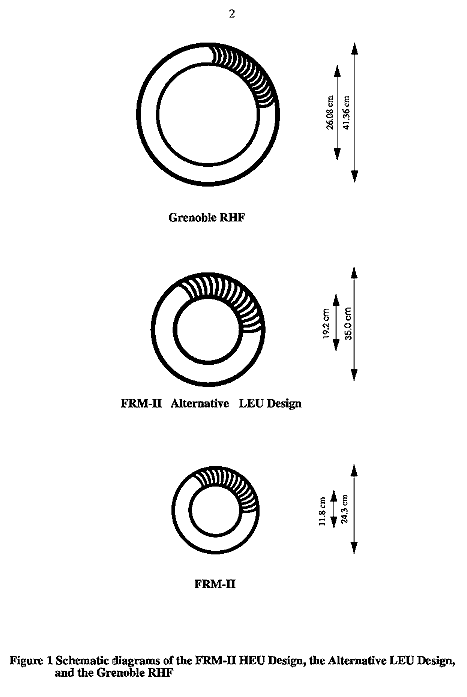
Table 1: Key Parameters of the FRM-II HEU Design and the Alternative LEU Design
| FRM-II
HEU Design |
FRM-II Alternative
LEU Design (a) |
|
| Enrichment, % | 93.0 | 19.75 |
| Reactor Power (MW) | 20 | 32 |
| Cycle Length (Full Power Days) (b) | 50 | 50 |
| Average Number of Cores/Year (c) | 5.0 | 5.0 |
| Peak Thermal Flux, keff fth,max (n/cm2/s) | 8 x 1014 | 8 x 1014 |
| Reflector Volume (liters) with keff fth>7x1014 n/cm2/s | 75 | 110 |
| Active Core Inner - Outer Radius (cm) | 6.75 - 11.2 | 10.45 - 16.55 |
| Active Core Height (cm) | 70 | 80 |
| Active Core Volume (liters) | 17.6 | 41.4 |
| Number of Fuel Plates | 113 | 172 |
| Core Loading (Kg U-235) | 7.5 | 7.5 |
| Fuel Type | U3Si2 | U3Si2 |
| Fuel Grading | Yes | No |
| Fuel Meat Uranium Density (g/cm3) | 3.0/1.5 | 4.5 |
| Fuel Meat/Clad Thickness (mm) | 0.60/0.38 | 0.76/0.38 |
| Inner/Outer Side Plate Thickness (cm) | 0.6/0.7 | 0.6/0.7 |
| Coolant Channel Thickness (mm) | 2.2 | 2.2 |
| Design Coolant Velocity, m/s | 18.0 | 18.0 |
| Width of Involute Plate (cm) | 6.83 | 8.735 |
| Keff at BOC | 1.1714 | 1.2101 |
| Core Average Burnup (% U-235 burned) | 17.3 | 25.9 |
| Average Fission Rate in Fuel Meat (fissions/cm3/s)
Peak Pointwise Fission Rate in Fuel Meat at BOC (d) |
2.1 x 1014
4.6 x 1014 |
1.2 x 1014
2.8 x 1014 |
| Average Fission Density in Fuel Meat (fissions/cm3)
Peak Fission Density in Fuel Meat at EOC (d) |
1.0 x 1021
1.5 x 1021 |
0.5 x 1021
0.9 x 1021 |
| Average Power Density in Core (W/cm3)
Peak Power Density in Core - rod out at BOC |
1139
2497 |
773
1835 |
| Peak Temperature in Fuel Meat (C) BOC/EOC | 150/180 | 130/160 |
(a) With involute plate width of 8.735 cm, as in lower core of ORNL's Advanced
Neutron Source design, (b) EOC excess reactivity = 5% k/k for both the HEU and
LEU designs;
(c) Based on 250 days operation per year; (d) In 3.0 g/cm3 fuel of
the HEU design.
2.2 Reactor Performance Comparisons
2.2.1 Lifetimes of the HEU and LEU Cores
As previously stated, two of the main design objectives for the Alternative LEU core were to match the 50-day fuel cycle length of the HEU design and to match the thermal neutron flux in the heavy water reflector. Figure 2 shows excess reactivity versus full power days operation for the HEU and LEU designs. Both cores could operate for 50 full power days (the HEU core at 20 MW and the LEU core at 32 MW) and have an end-of-cycle excess reactivity of about 5% k/k to account mainly for beam tubes and experimental facilities in the heavy water reflector.
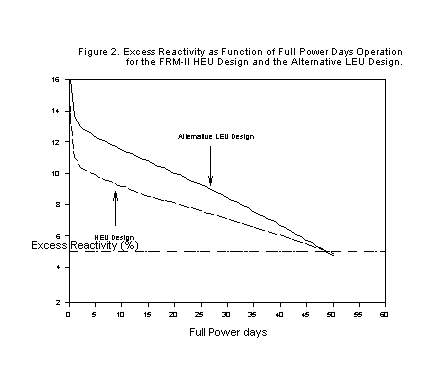
2.2.2 Neutron Fluxes and Neutron Spectra in Heavy Water Reflector
The thermal (E 0.625 eV) and fast (E 0.625 eV) neutron fluxes as a function of radial distance from the reactor vessel are compared in Figure 3 for the HEU and LEU designs. Also shown in Figure 3 for both designs are the neutron spectra in the heavy water reflector at the core centerline and at a radial distance of 50 cm from the reactor vessel. This location was chosen to compare the neutron spectra because it is a very likely location for key experimental facilities. Figure 3 shows that there are little or no differences in the magnitude and quality of the neutron fluxes in the HEU design and the Alternative LEU design.
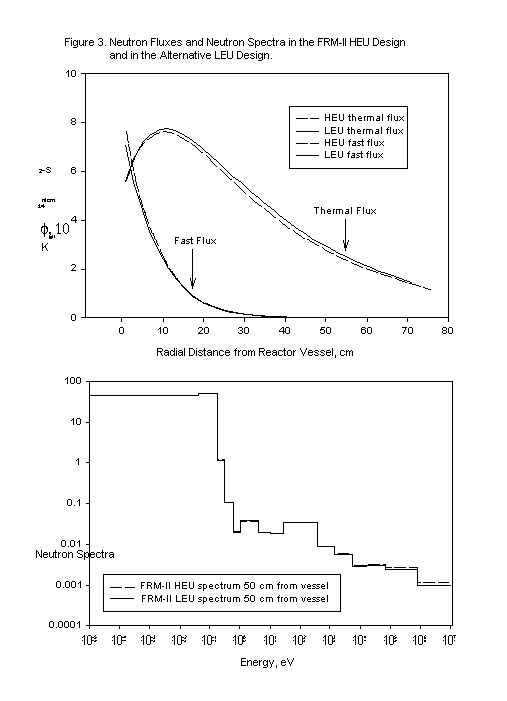
2.2.3 Gamma Heating in the Heavy Water Reflector
Coupled neutron-gamma analyses using the Monte-Carlo code MCNP were performed to compare the energy deposited (gamma heating) in the heavy water reflector of both the FRM-II HEU design and the alternative LEU design. These analyses show that a cold source operating in the alternative LEU design would make a good experimental facility even though the gamma heating would be slightly higher than in the HEU design.
The methodology for calculating gamma heating was first qualified by comparing calculated and measured data for the RHF (FOEHN)[15] reactor at Grenoble, France. These results are presented in Figure 4 and show excellent agreement. The uncertainty in the Monte Carlo analysis is less than 2% (1s). Figure 4 also shows the thermal neutron fluxes below 0.625 eV and the gamma fluxes in the heavy water reflector.
Results for the FRM-II HEU design and the alternative LEU design are also shown in Figure 4. If the cold source for the FRM-II were located at the same distance from the reactor vessel as the cold source for the RHF (about 50 cm from the vessel), the gamma heating per unit mass of reflector in the HEU and LEU designs would be about 0.064 W/g and 0.075 W/g, respectively. If the cold source were located closer to the core, the difference in gamma heating between the two designs would be even smaller. Results presented by TUM in Reference 6 show that the total heating (gamma and neutron) for the HEU design and the alternative LEU design are virtually the same (in Reference 6 the cold source is located at 40 cm and 45 cm from center of the core, for the HEU design and alternative LEU design respectively). A cold source operating in the alternative LEU design would make a good experimental facility even though the gamma heating would be slightly higher than in the HEU design. At a distance of 50 cm from the reactor vessel, the gamma heating in the HEU design would be a factor of 2.1 lower than in the RHF and the gamma heating in the LEU design would be a factor of 1.8 lower than in the RHF.

2.3 Qualification of HEU and LEU Silicide Fuels
The fuel meat in each plate of the FRM-II HEU design is composed of two radial regions with different uranium densities. A small part (about 1.25 cm in length) near the outer edge of each plate contains uranium with a density of 1.5 g/cm3. The rest of the meat (about 5.1 cm in length) contains fuel with a uranium density of 3.0 g/cm3. Thus, about 80% of the active core volume contains fuel with a uranium density of 3.0 g/cm3. HEU silicide fuel (U3Si2-Al) with 93% enrichment and a uranium density of 3.0 g/cm3 is totally untested and is not likely to be licensable without specific test data to qualify the fuel for use in the FRM-II.
In principle, HEU silicide fuel containing 93% enriched uranium with a density of 3.0 g/cm3 might perform well in the FRM-II. To our knowledge, however, no irradiation tests - not even on one single fuel plate - has been performed on this fuel through October 1996. Normal licensing practices in many countries require that tests be performed on the specific fuel that will be used in a reactor in order to provide the data on fuel behavior that is required for licensing. Minimal irradiation tests have been performed in the ORR reactor at the Oak Ridge National Laboratory by the RERTR Program on two miniplates containing U3Si2-Al fuel with 93% enrichment and a uranium density of 1.66 g/cm3. TUM has stated[5] that it plans to perform irradiation tests on HEU (93%) silicide fuel with 3.0 g/cm3 to provide the necessary proof that the fuel will perform well in the reactor.
LEU silicide fuel (U3Si2-Al) with uranium densities up to 4.8 g/cm3 is fully-qualified for conditions close to those of the FRM-II alternative LEU design. This fuel is available and can be licensed for routine use today.
This fuel was licensed by the U.S. Nuclear Regulatory Commission in 1988 for use in U.S. non-power reactors. The NRC safety evaluation report[16] on the fuel was issued after irradiation testing of several hundred specimens, including miniplates, full-size plates, full-size elements, and a full reactor core in the 30 MW ORR reactor at the Oak Ridge National Laboratory. Additional testing that made important contributions to and confirmed these results were performed in Germany, France, the Netherlands, Sweden, Denmark, Switzerland, Japan, and Canada. Fourteen research reactors currently operate with LEU U3Si2-Al fuel.
The high power reactors using LEU silicide fuel with a uranium density of 4.8 g/cm3 include the 50 MW JMTR reactor in Japan and the 70 MW OSIRIS reactor in France. This same fuel with a fuel meat thickness of 0.76 mm has been successfully tested in the 45 MW HFR reactor at Petten in the Netherlands. The 50 MW R2 reactor in Sweden routinely utilizes LEU silicide fuel with a fuel meat thickness of 0.76 mm and a uranium density of about 4.0 g/cm3. Over 400 elements with LEU silicide fuel, including about 8,000 plates, have been fabricated and irradiated with an excellent safety record.
A number of fuel meat parameters are important to define fuel behavior. Table 2 compares estimated values of four of these key parameters in the FRM-II alternative LEU design, the 50 MW JMTR reactor, and the 70 MW OSIRIS reactor. The FRM-II LEU design would operate under conditions very close to those under which the JMTR and OSIRIS reactors currently operate. LEU U3Si2-Al fuel with a uranium density of 4.4 g/cm3 has been irradiation tested in the JMTR reactor to a fission density of 0.7 x 1021 fissions/cm3 (33% U-235 burnup) at a temperature of 220C inside the fuel meat.
Table 2. Four Key Fuel Meat Parameters that Are Important in Defining Fuel Behavior
| Key Fuel Meat Parameters | Alternative FRM-II
LEU Design |
JMTR
LEU Fuel |
OSIRIS
LEU Fuel |
| Uranium Density (g/cm3) | 4.5 | 4.8 | 4.8 |
| Peak Fission Density at EOC (fissions/cm3) | 0.9 x 1021 | 0.7 x 1021 | 1.4 x 1021 |
| Time-Averaged Fission Rate (fissions/cm3/s) | 2.0 x 1014 | 1.6 x 1014 | 1.3 x 1014 |
| Peak Temperature in Fuel Meat BOC/EOC (C) | 130/160 | 125/155 | 105/135 |
| Other Parameters | |||
| Peak Pointwise Fission Rate (fissions/cm3/s) | 2.9 x 1014 | 3.1 x 1014 | 2.3 x 1014 |
| Residence Time in Core (Full Power Days) | 50 | 48 | 122 |
3. SAFETY EVALUATION
3.1 Fuel Element Hydraulic Stability
In Reference 6, TUM refers to the ANL alternative LEU design with an involute-type fuel plate having a width of 9.15 cm and a water velocity of 18 m/s and states: "Even if the somewhat lower power density and, therefore, coolant velocity is taken into account, this large value of the plate width could never guarantee the required plate stability." ANL does not agree with this statement by TUM. The analyses presented below show that the fuel element of both the HEU design and the alternative LEU design have hydraulic stability margins that are more than adequate.
3.1.1 Reactors and Designs Using Involute-Type Fuel Plates
The 100 MW High Flux Isotope Reactor (HFIR) at ORNL has operated successfully since 1965 using involute plates having a width of 8.38 cm in the inner fuel element and 7.48 cm in the outer fuel element. The nominal light water coolant velocity is 15.5 m/s.
The RHF reactor located at the Institut Laue-Langevin in Grenoble, France, has operated successfully since 1971 using involute plates having a width of 7.59 cm. The nominal heavy water coolant velocity of 15.5 m/s.
The ANS reactor design at ORNL had a lower fuel element containing involute plates having a width of 8.735 cm and a thickness of 1.27 mm. The water channel thickness was 1.27 mm and the nominal water velocity was 20-22 m/s. Experiments and analyses performed at ORNL determined that the fuel plates in this design would be stable during operation[17-21]. The "ANS plate-width" LEU design for the FRM-II shown in Table 1 has fuel plates having the same width (8.735 cm), but the plate thickness is 1.52 mm, the water channel thickness is 2.2 mm, and the nominal coolant velocity is only 18 m/s. All three factors (a thicker plate, a thicker water channel, and a lower coolant velocity) will increase the hydraulic stability of these LEU fuel plates over that of the already stable ANS design. The following analysis supports this conclusion.
3.1.2 Hydraulic Stability Analysis
To analyze the alternative LEU design for the FRM-II, a computer code was obtained from ORNL. This code (see Ref. 22, W. K. Sartory, "Analysis of Hydraulic Instability of ANS Involute Fuel Plates," ORNL/TM-11580) was one of the codes used in the ANS design to assess the hydraulic stability of the involute plates. After obtaining the ORNL code, the results presented in Figure 2 of ORNL/TM-11580 were reproduced to verify the correct use of the code. The code was then used to calculate the critical velocity for both the FRM-II HEU design and two alternative LEU designs, for the inner and outer fuel elements of the HFIR reactor at ORNL, for the RHF reactor in Grenoble, France, and for the upper and lower fuel elements of the ANS core designed by ORNL. These results are shown in Table 3. As seen from these data, the design coolant velocity for the FRM-II LEU design is smaller than the calculated critical velocity by a factor of about 3.7.
In addition, the Alternative LEU designs have peak fuel temperatures of 130/160°C at BOC/EOC, as compared with 150/180°C for the HEU design. The design coolant velocity in the LEU core can be reduced to 12 m/s from 18 m/s and have the same peak fuel temperatures of 150/180°C as the HEU design. This design velocity of 12 m/s would then be smaller than the calculated critical velocity by a factor of 5.6.
It is important to note that the critical velocity for the lower fuel element of the ANS is calculated to be about 47 m/s (over two times greater than the design velocity). Tests performed by ORNL (ORNL/TM-12353), "using full scale epoxy plate models of the aluminum/uranium silicide ANS involute-shaped fuel plates" show that if hydraulic instability were to occur, it would occur at a coolant velocity greater than the critical velocity predicted by the code. This indicates that the calculated results for the critical velocity presented in Table 3 are conservative and that both the HEU and alternative LEU designs have more than adequate hydraulic stability margins.
Table 3. Calculated Critical Coolant Velocity for Operating Reactors and Reactor Designs Using Involute-Shaped Fuel Plates.
Reactor or Reactor Design |
Fuel Plate Thick., mm |
Coolant Channel Thick., mm |
Involute Plate Width, cm |
Design Coolant Velocity m/s |
Calculated* Critical Coolant Velocity, m/s |
| FRM-II HEU | 1.36 | 2.20 | 6.83 | 18.0 | 89.9 |
| FRM-II LEU Same Plate-Width (8.735 cm) | 1.52 | 2.20 | 8.735 | 18.0** | 67.8 |
| as ANS Lower Fuel Element | |||||
| RHF Grenoble, HEU | 1.27 | 1.80 | 7.59 | 15.5 | 73.8 |
| HFIR Inner Fuel Element, HEU | 1.27 | 1.27 | 8.38 | 15.5 | 58.8 |
| HFIR Outer Fuel Element, HEU | 1.27 | 1.27 | 7.48 | 15.5 | 65.8 |
| ANS Lower Fuel Element, HEU Design | 1.27 | 1.27 | 8.735 | 20 - 22 | 46.8 |
| ANS Upper Fuel Element, HEU Design | 1.27 | 1.27 | 7.03 | 20 - 22 | 64.6 |
* Calculations were performed using a code developed by ORNL. See ORNL-11580,
Ref. 6.
** The coolant velocity in the Alternative LEU design could be reduced to 12
m/s and have the same peak fuel temperatures as the HEU design.
It is known that the methodology used for the analyses described above is based on older (1991) ANS project analysis techniques. A more sophisticated approach[23] adopted later by ORNL for ANS plate design also involves analyses of the thermal stress loads, conditions for attachment of the fuel plates to the side plates, and dynamic pressures. These more sophisticated analyses and experimental work[17-21] concluded that the design of the ANS lower fuel element is indeed hydraulically stable.
It is clear that if the alternative LEU design is adopted, detailed analyses and tests similar to those performed for the ANS in Refs. 17-21 would need to be done and a prototype core would need to be flow tested. However, based on the very positive results that have already been obtained for the ANS design, we believe that the Alternative LEU Design for the FRM-II has a large safety margin with respect to hydraulic stability.
3.2 Hypothetical Accident Involving the Moderator Material of the Reflector
Monte Carlo calculations were performed for FRM-II HEU design and the alternative LEU design to evaluate the subcriticality margins for a hypothetical accident in which the heavy water reflector is replaced by light water. Results of this analysis show that the HEU design is subcritical by about 16% k/k and that the alternative LEU designs is subcritical by about 8% k/k. These results conservatively assume that the central control rod has its beryllium follower in the core in its most reactive configuration. As a result, both cores satisfy this safety criteria.
3.3 Loss of Primary Coolant Flow Transient
A loss of primary flow transient analysis for the FRM-II HEU design is described by TUM in Ref. 2. ANL has analyzed this transient for both the HEU and alternative LEU designs using essentially the same assumptions as in Ref. 2 and concludes that fuel integrity is maintained with a considerable safety margin in both cases. Decay heat can be removed by natural circulation from both the HEU and LEU cores for at least seven days, making a strong inherent safety case for both designs.
Based on Ref. 2, "A loss of offsite power causes the simultaneous loss of all four primary pumps. In order to provide sufficient time to detect the accident and shutdown the reactor with the safety rods, the pumps are equipped with flywheels. Including uncertainties, the reactor trip point of the mass flow signal is reached 1.8 seconds after the loss of the pumps and the reactor is shutdown 0.5 seconds later." The following assumptions were made in the ANL analyses because detailed design information was not available:
(1) Before initiation of the transient, the HEU design was operated for 50 days at its nominal power of 20 MW and the LEU design was operated for 50 days at its nominal power of 32 MW. These conditions were used to generate the power history for the decay heat in the HEU and LEU cases.
(2) All decay heat (gamma and beta) is deposited in the fuel. That is, the peak power profile is the same as for the reactor during operation. This is a conservative assumption because a major fraction of the gamma power is deposited outside of the core in the heavy water reflector and reactor shielding.
(3) The light water pool has a diameter of 5 m and a depth of 14 m (Ref. 1).
(4) The initial light water pool temperature is 37° (Ref. 1).
(5) The DC-driven pumps have a flow rate equivalent to 6% of the AC-driven pumps,
(6) The DC-driven pumps operate for only three hours after onset of the transient (Ref. 2).
(7) There is no heat loss from the light water pool during the transient.
(8) At 100 seconds after the onset of the transient, the battery-supplied emergency core cooling pumps are started to maintain the forced flow for three hours. In Ref. 2, these pumps are started at the time of the trip, at about 1.8 seconds after the transient is initiated. Thereafter, the natural circulation flaps open automatically and the decay heat is removed by natural circulation.
The safety margin against flow instability reaches its lowest value of 4.0 (3.5 in Ref. 2) for the HEU design and 4.4 for the alternative LEU design after 2.3 seconds. (The value of the bubble detachment parameter eta was taken to be 47.8 in calculating the margin against flow instability, as suggested in Ref. 24 by Interatom, now Siemens). These safety margins of 4.0 for the HEU design and 4.4 for the LEU design are to be compared with the minimum required value of 1.5 (Ref. 2). It follows that the fuel integrity is maintained with a considerable safety margin in both the HEU and alternative LEU designs.
Additional results of this analysis are plotted in Fig. 5 for both the HEU and alternative LEU designs. During the first seven days after initiation of the transient: (1) the temperature of the cladding in both cores is less than 120°C, far below the clad melting temperature of about 580°C and (2) the temperature of the light water pool is about 80°C in the alternative LEU design and about 60°C in the HEU design. As a result, the decay heat can be safely removed from the core by natural circulation for at least seven days, making a strong inherent safety case for both designs.

This section addresses the radiological consequences of (1) increased plutonium production in LEU fuel and (2) the larger fission product inventory in the higher-powered alternative LEU design for the case of hypothetical accidents involving core melting. The results of this analysis show that the alternative LEU design meets in full the radiological consequences criteria[6] set by the German Ministry of Environment (Bundesministerium fur Umwelt - BMU).
The plutonium produced in the FRM-II core is calculated to be 10.4 grams in the HEU design and 158.5 grams in the alternative LEU design. This increased plutonium production in the LEU design is not an issue by itself. Irradiated LEU fuel will always contain a larger plutonium inventory than irradiated HEU fuel. The pertinent question is the impact that this increased plutonium inventory will have on the radiological consequences of hypothetical accidents. In the analyses discussed below, the plutonium inventory of the FRM-II LEU design has no impact on the radiological consequences for hypothetical accidents involving melting of the core in water. In the analysis, the very conservative assumption was made that 0.015% of the plutonium inventory was released into the air of the reactor building. No credit was taken for plate-out of plutonium on reactor structures and no credit was taken for air filters.
It is expected that the inventory of fission products (other than plutonium) and their radiological consequences will be a factor of about 1.6 higher in the LEU design than in the HEU design because the power level of the LEU design is 1.6 times higher and both designs would operate for 50 days. As an example to confirm this expectation, doses were calculated for both the HEU and LEU designs using the same assumptions for atmospheric conditions, breathing rates, stack height, building leak rate, release factors for noble gases, halogens, and cesium[2], and release factors for other radioactive isotopes[25]. The results of this analysis for a hypothetical accident in which the whole core would be molten under water are presented in Table 4. The conclusion is that the total doses, for any organ and at any time after the release, are nearly directly proportional to the reactor power level.
Table 4. Example Dose Calculations for the FRM-II HEU and LEU Designs for a Hypothetical Accident in Which the Entire Core Would Be Molten Under Water (500 m from the source).
| FRM-II HEU Design
Dose (mSv) for Entire Core |
Alternative LEU Design
Dose (mSv) for Entire Core |
Ratio of
LEU Dose to HEU Dose |
|
| Bone | 34.0 | 54.1 | 1.59 |
| Lung | 33.6 | 54.1 | 1.61 |
| Thyroid | 0.046 | 0.074 | 1.61 |
| Whole Body
Internal |
1.6 | 2.6 | 1.63 |
| Whole Body
External |
6.5 | 10.1 | 1.55 |
Since the radiological consequences for hypothetical accidents involving the entire core are directly proportional to the reactor power level, the consequences of any postulated accident for the LEU design can be obtained directly from the results provided by TUM in Ref. 6, and reproduced here as Figure 6. In this Figure, the LEU integrated doses for Adults and Infants are presented together with those calculated by TUM for the HEU design. These results clearly show that for both the HEU design and the alternative LEU design, the integrated doses for both adults and infants are lower than the minimum value for which evacuation may be required, according to the norms of the BMU. This bound is shown as 100 mSv in Figure 6.
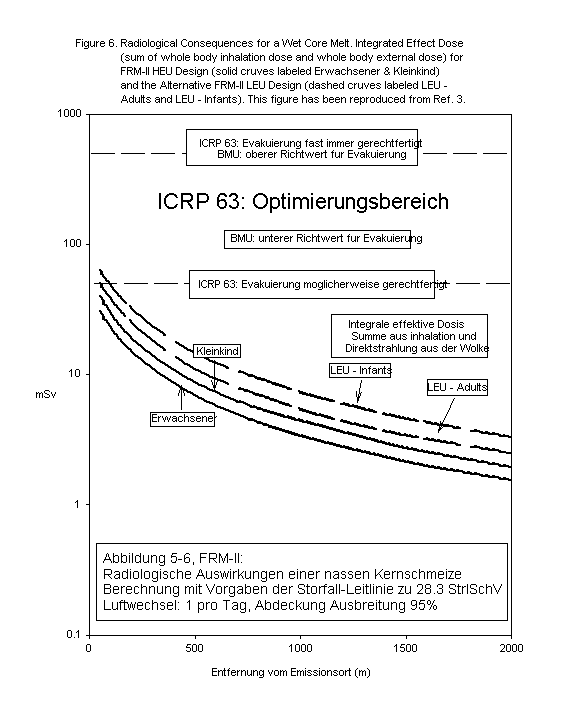
4. COST AND SCHEDULE
The design features and results obtained in this study are very different from those used by the TUM in their assessment of the costs involved in using LEU fuel in the FRM-II[6]. For example, the LEU core discussed here has one fuel ring (instead of two), a power level of 32 MW (instead of 40 MW), and requires only 59 more plates than the HEU core (instead of 226 more plates). One consequence of the difference in the additional number of fuel plates per core is that a direct extrapolation of the TUM's estimate of the cost increase to operate the FRM-II for 30 years with LEU fuel would be 78 Mio DM instead of 300 Mio DM. In addition, the LEU fuel plates will be simpler to fabricate because they are not graded and would require only one compact per plate instead of two, as in the HEU design. Therefore, it is imperative that cost and schedule issues be thoroughly reviewed, taking into account the results presented in this study.
5. LEU CONVERSION OF THE HEU DESIGN
The FRM-II HEU design is based on a very-compact reactor core concept that requires high density HEU fuel to achieve its performance objectives . Only by increasing the size of the HEU core is it possible to use LEU fuel in the FRM-II and have a comparable core lifetime and experiment performance. There is no possibility whatsoever that a suitable LEU fuel will be developed for HEU geometry.
To illustrate this point, calculations were done in which LEU uranium metal with a density of 19 g/cm3, a totally unrealistic possibility, was substituted for the fuel meat of the HEU design. The result was that the core would operate for only about 25 days at a power level of 20 MW and would have a peak thermal flux of 7 x 1014 n/cm2-s in the heavy water reflector. This performance level would not be acceptable.
6. CONCLUSIONS
6.1 Lifetimes of the HEU and LEU Core Designs
Both the HEU and LEU cores can operate for 50 full power days (the HEU core at 20 MW and the LEU core at 32 MW) and have an end-of-cycle excess reactivity of about 5% k/k to account mainly for beam tubes and experimental facilities in the heavy water reflector.
6.2 Neutron Fluxes and Neutron Spectra in the Heavy Water Reflector
Both cores can produce a peak thermal flux of about 8 x 1014 n/cm2/s in the heavy water reflector. There are little or no differences in the magnitude and quality of the neutron fluxes and neutron spectra between the HEU and LEU designs.
6.3 Gamma Heating in the Heavy Water Reflector
Detailed analyses comparing the energy deposited (gamma heating) in the heavy water reflector of both the FRM-II HEU design and the ANL LEU design showed that a cold source operating in the heavy water reflector of the LEU design would make a good experimental facility even though the gamma heating would be slightly higher than in the HEU design. At a distance of 50 cm from the reactor vessel, the gamma heating in the HEU design would be a factor of 2.1 times lower than in the RHF reactor at Grenoble, France, and the gamma heating in the LEU design would be a factor of 1.8 lower than in the RHF.
6.4 Qualification of HEU and LEU Silicide Fuels
HEU silicide fuel (U3Si2-Al) with 93% enrichment and a uranium density of 3.0 g/cm3 is untested and is not likely to be licensable without specific test data to qualify the fuel for use in the FRM-II. Normal licensing practices in many countries require that tests be performed on the specific fuel that will be used in a reactor in order to provide the data on fuel behavior that is required for licensing. TUM has stated that it plans to perform irradiation tests on HEU (93%) silicide fuel with 3.0 g/cm3 to provide the necessary proof that the fuel will perform well in the reactor.
LEU silicide fuel (U3Si2-Al) with uranium densities up to 4.8 g/cm3 is fully-qualified for conditions close to those of the FRM-II LEU design. This fuel was licensed by the U.S. Nuclear Regulatory Commission in 1988 for use in U.S. non-power reactors. The fuel was qualified by means of extensive irradiation testing and post-irradiation examination of miniature fuel plates, full size elements, and a whole-core demonstration. LEU silicide fuel is available and can be licensed for routine use today in the FRM-II.
Detailed analyses of critical velocity of fuel plate collapse showed both the FRM-II HEU design and the alternative LEU design have adequate hydraulic stability margins. The design coolant velocity for the alternative LEU design is smaller than the calculated critical velocity by a factor of about 3.7.
6.6 Loss of Primary Coolant Flow Transient
A loss of primary flow transient analysis for the FRM-II HEU design is described by TUM in Ref. 15. ANL has analyzed this transient for both the HEU and alternative LEU designs using the same assumptions and concludes that fuel integrity is maintained with a considerable safety margin in both cases. Decay heat can be removed by natural circulation from both the HEU and LEU cores for at least seven days, making a strong inherent safety case for both designs.
Analyses of the radiological consequences of increased plutonium production in LEU fuel and larger fission product inventory in the higher-powered ANL LEU design for the case of hypothetical accidents involving core melting showed that the ANL LEU design meets in full the radiological consequences criteria set by the German Ministry of Environment (Bundesministerium fur Umwelt - BMU).
The plutonium that would be produced in the HEU and LEU cores were calculated to be 10.4 g and 158.5 g, respectively. Analyses performed in this study showed that the increased plutonium inventory in the LEU core would have no impact on the radiological consequences of hypothetical accidents involving melting of the core in water, even with very conservative release assumptions. The study also showed that the radiological consequences for a wet core melt with either the HEU design or the ANL LEU design are within the norms established by the BMU.
The design features and results obtained by ANL for the alternative LEU design are very different from those used by TUM in its assessment of the costs involved in using LEU fuel in the FRM-II. Thus, a careful review of both cost and schedule issues is needed.
6.9 LEU Conversion of the HEU Design
The FRM-II HEU design is based on a very-compact reactor core concept that requires high density HEU fuel to achieve its performance objectives . Only by increasing the size of the HEU core is it possible to use LEU fuel in the FRM-II and have a comparable core lifetime and experiment performance. There is no possibility whatsoever that a suitable LEU fuel will be developed for HEU geometry.
Based on the excellent results for the Alternative LEU Design that were obtained in these analyses, the RERTR Program concludes that all of the major technical issues regarding use of LEU fuel instead of HEU fuel in the FRM-II have been successfully resolved and that it is feasible to use LEU fuel in the FRM-II without compromising the safety or performance of the facility. In this regard, the RERTR Program would like to reiterate its strong support for construction of the FRM-II reactor using LEU silicide fuel and its readiness to exchange information with the TUM to resolve any technical issues that may still exist.
REFERENCES
1. "Neutron Source Munich FRM-II, Project Status Report presented by project group "New Research Reactor" of the Department of Physics E21, Technical University of Munich, March 1992, ORNL/TR-92/17.
2. K. Böning and J. Bombach, "Design and Safety Features of the Planned Compact Core Research Reactor FRM-II", Proceedings of the XIV International Meeting on Reduced Enrichment for Research and Test Reactors, 4-7 November 1991, Jakarta, Indonesia, published by Badan Tenaga Atom Nasional, 1995, p. 367.
3. S.C. Mo, N.A. Hanan and J.E. Matos, "Comparison of the FRM-II HEU Design With an Alternative LEU Design" and N.A. Hanan, S.C. Mo, R.S. Smith, and J.E. Matos, "Attachment to Comparison of the FRM-II HEU Design With an Alternative LEU Design", Proceedings of the XVIII International Meeting on Reduced Enrichment for Research and Test Reactors, 17-21 September 1995, Paris, France.
4. N.A. Hanan, S.C. Mo, R.S. Smith, and J.E. Matos, "An Alternative LEU Design for the FRM-II", Proceedings of the 1996 International Meeting on Reduced Enrichment for Research and Test Reactors, 7-11 October 1996, Seoul, Korea, to be published.
5. A. Axmann and W. Gläser, Statement made at the "U.S.-German Bilateral Technical Talks on FRM-II held in Tegernsee, Germany on 18 January 1996".
6. K. Böning, "Viewgraphs presented at the RERTR International Meeting in Paris, France, September 19, 1995", Attachment to letter from K. Böning, Technical University of Munich, to J.E. Matos, Argonne National Laboratory, October 6, 1995, and K. Böning, "Comment on the Contribution of S.C. Mo, N.A. Hanan and J.E. Matos: Comparison of the FRM-II HEU Design With an Alternative LEU Design", Proceedings of the XVIII International Meeting on Reduced Enrichment for Research and Test Reactors, 11-21 September 1995, Paris, France.
7. "U.S.-German Bilateral Technical Talks on FRM-II in Tegernsee on Jan. 18, 1996. ANL Proposal of an Alternative LEU Design", Letter from Klaus Böning, Technical University of Munich to J. E. Matos, Argonne National Laboratory, January 30, 1996.
8. "Resolution of TUM-ANL Discrepancy in Lifetime of Alternative LEU Design", Letter from J.E. Matos, Argonne National Laboratory to Klaus Böning, Technical University of Munich, February 23, 1996.
9. J. M. Ryskamp, D. S. Selby and R. T. Ptimms III, "Reactor Design of the Advanced Neutron Source," Nucl. Tech., vol. 93 Mar. 1991.
10. K. L. Drestine, "DIF3D: A Code to solve One-, Two- and Three Dimensional Finite-Difference Diffusion Theory Problems," ANL-82-64, April 1984.
11. J. R. Deen, W. L. Woodruff and C. I. Costescu, "WIMS-D4M User Manual Rev. 0", ANL/RERTR/TM-23, Argonne National Laboratory, July 1995.
12. J. F. Briesmeister, "MCNP-4A General Monte Carlo N-Particle Transport Code," LA-12625-M, Los Alamos National Laboratory, Nov. 1993.
13. B. J. Toppel, "A User's Guide for the REBUS-3 Fuel Cycle Analysis Capability," ANL-83-2, March 1983.
14. S. C. Mo, "Methodology and Application of the WIMS-D4M Fission Product Data," Proceedings of the 1994 International Meeting on Reduced Enrichment for Research and Test Reactors, September 17-23, 1994, Williamsburg, Virginia, USA, to be published.
15. K. Scharmer and H.G. Eckert, "FOEHN: L'Expérience Critique pour le Réacteur a Haute-Flux Franco Allemand".
16. U.S. Nuclear Regulatory Commission, "Safety Evaluation Report Related to the Evaluation of Low-Enriched Uranium Silicide-Aluminum Dispersion Fuel for Use in Non-Power Reactors", NUREG-1313, July 1988.
17. W. F. Swinson, R.L. Battiste, C.R. Luttrell, and G.T. Yahr, "Fuel Plate Stability experiments and Analysis for the Advanced Neutron Source", ORNL/TM-12353, Martin Marietta Energy Systems, Inc., Oak Ridge National Laboratory, May 1993.
18. W. F. Swinson, R.L. Battiste, C.R. Luttrell, and G.T. Yahr, "Follow-up Fuel Plate Stability Experiments and Analyses for the Advanced Neutron Source", ORNL/TM-12629, Martin Marietta Energy Systems, Inc., Oak Ridge National Laboratory, November 1993.
19. W. F. Swinson, C.R. Luttrell, and G.T. Yahr, "An Examination of the Elastic Structural Response of the Advanced Neutron Source Fuel Plates", ORNL/TM-12712, Martin Marietta Energy Systems, Inc., Oak Ridge National Laboratory, September 1994.
20. W. F. Swinson, R.L. Battiste, and G.T. Yahr, "Circular Arc Fuel Plate Stability Experiments and Analyses for the Advanced Neutron Source", ORNL/TM-12977, Martin Marietta Energy Systems, Inc., Oak Ridge National Laboratory, August 1995.
21. W. F. Swinson, R.L. Battiste, and G.T. Yahr, "Structural Thermal Tests on Advanced Neutron Source Reactor Fuel Plates", ORNL/TM-13062, Martin Marietta Energy Systems, Inc., Oak Ridge National Laboratory, August 1995.
22. W.K. Sartory, "Analysis of Hydraulic Instability of ANS Involute Fuel Plates", ORNL/TM-11580, Martin Marietta Energy Systems, Inc., Oak Ridge National Laboratory, November 1991.
23. "Comments on a paper presented by ANL at the U.S.-German Bilateral Technical Talks on FRM-II in Tegernsee, Germany on January 18, 1996", Letter from C.D. West, Oak Ridge National Laboratory to A. Travelli, Argonne National Laboratory, February 8, 1996.
24. "INTERATOM: Safety Analyses for the IAEA Generic 10 MW Reactor" IAEA Research Reactor Core Conversion Guidebook, IAEA-TECDOC-643, April 1992, Volume 2, Analysis, page 15.
25. H-N Jow, et. Al., "XSOR Codes Users Manual", NUREG/CR-5360, Sandia National Laboratories, November 1993.
APPENDIX A
RESOLUTION OF TUM-ANL DISCREPANCY IN THE LIFETIME
OF THE ALTERNATIVE LEU DESIGN
February 23, 1996
Dr. Klaus Böning
Technical University of Munich
Garching, FRM-II Reaktorstation
D-85747 Garching, Germany
Dear Dr. Böning:
Subject: Resolution of TUM-ANL Discrepancy in Lifetime of Alternative LEU Design
We would like to thank you for sending us a copy of the viewgraphs that you presented at the U.S.-German Bilateral Technical Talks on FRM-II in Tegernsee on 18 January 1996. We also want to thank Mr. Nuding for sending us the TUM DIF2D model for the FRM-II HEU design and the TUM model for the ANL Alternative LEU design. Mr. Nuding was also very helpful in answering several questions that we had on the TUM models.
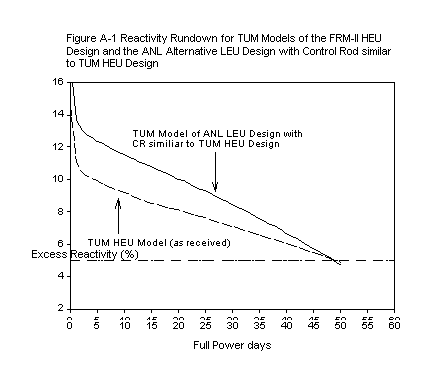
Based on our calculations of the TUM models, we have two main conclusions: (1) Both the HEU Design and the Alternative LEU Design for the FRM-II will operate safely for 50 days with very nearly the same experiment performance (See Figure A-1 and A-2). Calculations performed by TUM and by ANL with the same design model will give the same results (See Figure A-2).
The "discrepancy" that was discussed in Tegernsee can be resolved by referring to Figure 2. The solid curve is our reactivity rundown for the TUM HEU model that we received. The middle curve is our reactivity rundown for the TUM model of the ANL LEU Design that we received from Mr. Nuding. The top curve is the same as the middle curve, but with a uranium enrichment of 19.75%, instead of the 19.28% enrichment that we received in the model from Mr. Nuding.
The middle curve shows that with the TUM model and assumptions we also obtain a lifetime of 35 days for the LEU design, as you stated. However, when we remove two assumptions that we believe to be incorrect, we find that the LEU core will operate for 50 days (top curve), as we stated. If the end of cycle excess reactivity is taken to be the same 5% for both the HEU core and the LEU core, the middle curve shows that the LEU core would operate for about 47 days. If the uranium enrichment is then increased from the 19.28% value in Mr. Nuding's model to the standard 19.75% enrichment for LEU fuel, the lifetime becomes 50 days.
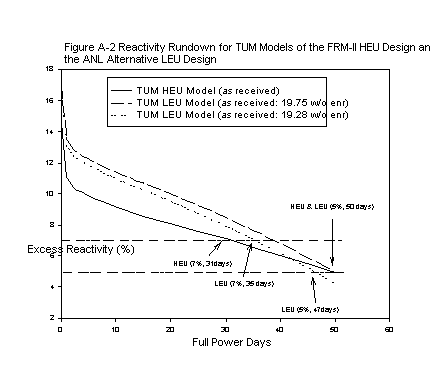
Please let us know if you disagree with our interpretation of the "discrepancy".
Sincerely,
J. E. Matos
cc: H. Schunck, BMBF, Germany
R. Ries, American Embassy, Bonn
J. Wolfsthal, U.S. Department of Energy
E. Busick, U.S. Department of State RERTR Program



